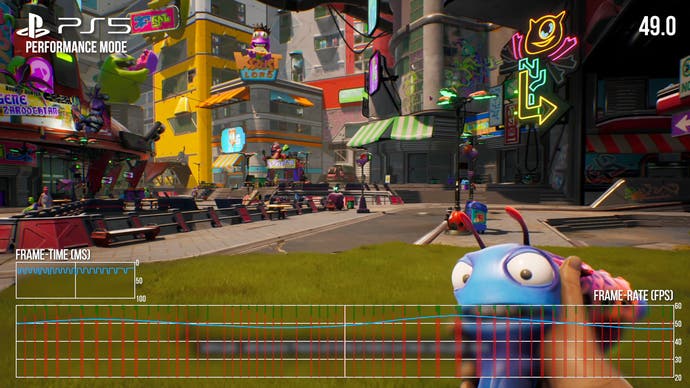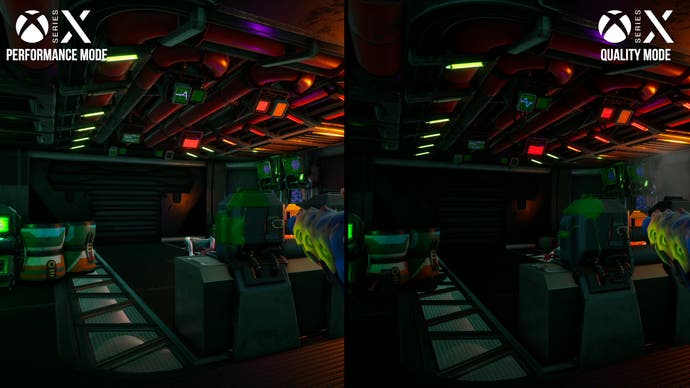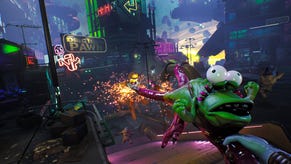High on Life comes to PS5 with performance and animation issues that need addressing
Every console version tested.
High on Life is an an offbeat first-person shooter, with Halo-style combat mechanics, acrobatic platforming, and acerbic humour voiced by major American comedians. It stands out in a world of games that take themselves all too seriously, making for a compelling experience when it launched last year on Xbox consoles and PC. After eight months of Microsoft exclusivity, the game's finally come to PS4 and PS5, bringing along major game updates that have fixed long-standing flaws. Do these new versions do High on Life justice, and do the game's UE4 visuals hold up across seven distinct console platforms?
High on Life isn't a complicated game at its core, though it does have some interesting gameplay flourishes. Combat is built around a few distinct weapons, which come packed with a mix of zoom modes and special actions. Encounters tend to be quite dynamic, with floaty jumps and dashes enabling the player to mix it up at a variety of ranges with enemy squads. The gunplay isn't quite at the same level mechanically as Halo or Destiny, but it can feel satisfying, especially once you unlock later firearms. Encounters are often separated by platforming challenges and simple puzzles to break up the pace, making for a breezy little shooter.
Beyond its mechanics, High on Life leans heavily on a metatextual sense of humour to keep the story moving. This isn't going to appeal equally to all players, but I found it amusing enough. A lot of gaming stories are pretty forgettable and while High on Life isn't completely my cup of tea, it kept me more engaged than most titles. Plus, I doubt the scope of a game like this could warrant the kind of carefully-crafted cinematics needed to pull off a dramatic story anyway.
That said, High on Life fares surprisingly well from a basic visual perspective. The game world is colourful and vibrant, assets are detailed and the lighting looks convincing much of the time. High on Life has a very UE4-derived look to it and makes the most of that engine's feature set - at least up to the level of cross-gen games. That means a mix of high-quality baked lighting and ambient occlusion to handle indirect lighting, a heavy reliance on screen-space effects and excellent TAA with motion blur. It's perfectly competent and looks quite attractive in motion, but isn't pushing beyond other UE4 titles.
There are definite issues as well. High on Life suffers from distracting pop-in at times, with smaller objects and some shadows appearing very close to the player character. I noted a handful of visual bugs while playing on PS5 as well, problems like jittery shadowmaps and flickering objects. I don't think the materials work is great here, with most objects tending to have a bit of a plasticky gloss, especially in indirectly-lit conditions. Plus, the levels are somewhat repetitive and dialogue sequences are fairly basic, which do betray the game's somewhat lower production values compared to big-budget titles.
That said, there are a handful of unique visual touches that I appreciated. The various guns in the game have wide, expressive faces, and their eyes track NPC characters as you chat with them, which looks quite cool. Weapons seem somewhat rigid, but their flesh jiggles as you move through the world and they recoil violently when shot. Subtle tilts of the player weapons help to make the platforming feel quite responsive. The first-person animation in general is really top-notch.

So in terms of basic visuals, the developers have done a good job. It might be unexceptional relative to recent UE4 efforts, but the game makes effective use of the engine's key features to deliver a vibrant, visually-interesting game world.
Unfortunately, this presentation is marred by some unpleasant performance on PS5. Looking at the default performance mode, there are some dropped frames at times, which are often accompanied by tearing in the top fifth of the screen. This isn't too bad and pops up infrequently, though the game does suffer from one curious performance issue that doesn't show up on a frame-rate graph.
Essentially, High on Life has an annoying animation issue that makes the game seem like it's dropping frames, even at a stable 60fps. The player camera and certain animations will move at an uneven rate between frames, making animation feel very awkward. This doesn't pop up all the time, but it does consistently recur at certain locations for some reason, like the central city area. It's similar to the animation issues in Ghostrunner on Series S, the first game I covered for Digital Foundry about two years ago, which is also an Unreal Engine 4 title.

The original console release of High on Life on Xbox Series consoles actually suffered from the same issue to a greater degree, with intrusive animation problems in most gameplay - but this was quickly corrected in a post-launch patch. It's therefore a disappointment to see the same problem reoccur on the brand-new PS5 version but hopefully the developers can stamp out the issue on Sony's platform promptly. Thankfully, the quality mode - which targets 30fps - doesn't seem to have this issue at all and maintained a locked frame-rate throughout my capture, but obviously, a higher frame-rate benefits a first-person shooter.
For the moment, current-gen Xbox systems fare much better than PS5 in performance terms at least. Both the quality and performance modes on Series S and X behave just about perfectly, hitting a solid 30fps and 60fps respectively with no animation issues. I did notice some minor one-off dropped frames during an especially demanding early sequence, although in typical play we're looking at a perfectly flat line on both the frame-rate and frame-time graphs.
Visual features do differ between the two graphical modes on offer on current-gen consoles. The quality mode offers improved shadow quality, increased distant detail, extra fog and smoke effects, and improved ambient occlusion. The visual differences between the two modes can be quite stark, whether seen on Series X and Series S, though both Series S modes have lower texture resolutions than on Series X.

PS5 is mostly the same as Series X, but there's one key difference: the ambient occlusion improvements appear to be mostly absent on the Sony console in its quality mode. In the shots I tested, the AO coverage looks very similar between its quality and performance modes. This is likely a bug, or else an odd omission.
There are some surprises when it comes to pixel counts as well. Series S is circa 1080p in both modes, with the extra performance headroom when running at 30fps presumably going to those enhanced visual features. Series X is much the same, coming in at ~1440p in every shot I tested. Conversely, PS5 averages ~1800p in its performance mode, with substantial variance here between frames, while quality mode is consistently at ~2160p. In practice, PS5 and Series X look smooth and typically operate without substantial aliasing, though the PS5 does have a considerable advantage in image clarity against Series X.
Despite the PS5's higher resolution, the incumbent Series S and X versions seem more polished. The PS5's animation pacing issues and frame-rate wobbles are absent on Microsoft's ninth-gen platforms, and they feature properly calibrated performance and quality visual modes. It seems like the PS5 version of High on Life needed more time in the oven, and the animation pacing issues are a particularly glaring problem.

Last-gen consoles also get the High on Life treatment, including new PS4 and PS4 Pro releases. Visual features look on par with the Series S version in its performance mode, but there are a few extra cutbacks - like lower shadow resolution, less shadow coverage and reduced foliage density. Image quality is fine too, though both PS4 and PS4 Pro seem to render around 900p, suggesting Sony's enhanced machine isn't being pushed maximally.
In performance terms, PS4 faces some issues with considerable hitching at times in addition to more minor frame-time blips. Loading is also pretty egregious compared to the current-gen models, whether from the main menu or in-game. PS4 Pro fares about the same, though larger stutters did seem less frequent. It's a serviceable enough experience, but like a lot of recent cross-gen titles you can tell the focus wasn't on last-gen machinery.
The Xbox One platforms operate similarly, with the same hitching and loading problems. The One S version is saddled with extra concerns too, with more frequent frame-time dips and extended drops as well. In terms of resolution, One S is ~792p and One X is ~1080p, the latter being towards the lower end of what we usually expect from that console.
Last-gen Xboxes do get a better version of High on Life than I anticipated, with earlier coverage highlighting issues with frame-rate capping on Xbox One consoles. All eighth-gen platforms seem to deliver a properly-paced 30fps output now, though they obviously have other substantial problems. Notably, none of the last-gen platforms exhibit any of the animation issues we see on PS5.

High on Life is a good-looking game and an entertaining adventure that I enjoyed playing. The basic visual presentation is quite pleasing, with great use of the UE4 feature set. Performance is the key complaint, as PS5 suffers from the animation pacing issue that plagued the Xbox Series versions on launch. It feels fine most of the time, but when the game is experiencing animation issues it's off-putting.
Last-gen consoles also have a range of problems, with the kind of hitches and lengthy loads we often see in last-gen titles nowadays. It's not ideal, but they're definitely playable - though One S predictably does struggle a little bit more to hold a 30fps update.
The new editions of High on Life come in mostly as expected then, after post-release patches cleared up the bigger issues on the existing Xbox releases. However, the PS5's animation pacing problems need to be addressed, just as they were on Xbox Series S and X last year.
















